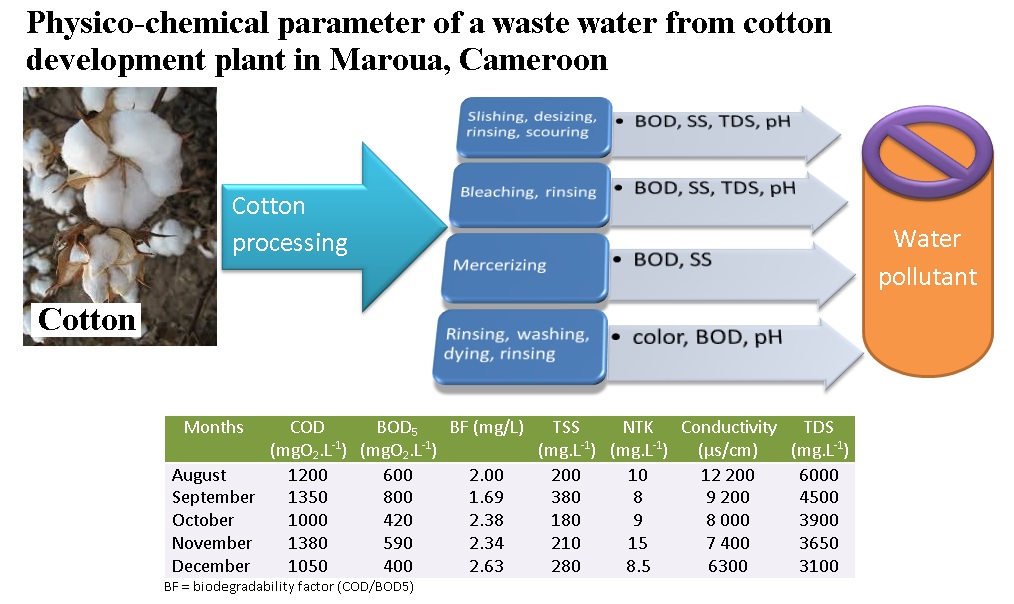Study on Physico-Chemical Parameters of Wastewater Effluents from Cotton Development Plant of Maroua-Cameroon
Abstract

The present research work deals with the study of some of the important physico-chemical parameters of wastewater effluents collected from Maroua cotton processing plant named “SODECOTON”. The effluents were studied from the month of June 2016 to August 2017. A preliminary investigation was carried out on the source of water used by the plant and management of its wastewater effluent. All parameter were analyzed as per the standard methods. Water quality parameters such as temperature, pH, Electrical Conductivity, Total Dissolved Solid, Total Suspended Solid, Biological Oxygen Demand, Chemical Oxygen Demand, Total Nitrogen Kjeldahl, Nitrate and Phosphate were analysed. Results of this study shows that nearly all values of these parameters were above permissible limit. These values are significantly higher during the rainy season (from May –December) than dry season (January-April). Water used by the plant is from bore hole. This water is treated by less adapted technology prior to use and thus probably contribute in the pollution load of the plant’s wastewater effluent. Wastewater from the plant is discharged without being treated and without any quality analysis. This behaviour is due to very relax regulation, absence of monitoring and enforcement by government authorities.
References
[1] Hanchang, SHI. Point sources of pollution: local effects and its control. – Vol. I - Industrial Wastewater-Types, Amounts and Effects, P 442, ISBN: 978-1-84826-167-9 (eBOOK)
[2] WHO., 2002, Water Pollutants: Biological Agents, Dissolved Chemicals, Non-dissolved Chemicals, Sediments, Heat, WHO CEHA, Amman, Jordan
[3] Tamburlini,G., Ehrenstein,O.V. and Bertollini R.,2002, Children’s Health and Environment: A Review of Evidence, In: Environmental Issue Report No. 129, WHO/European Environment Agency, WHO Geneva, pp 223. website
[4] Kupechella, C.E. and Hyland M.C., 1989, Environmental Science, Allyn and Baron, London
[5] Novick, R., 1999, Overview and the Health in Europe in the 1990s, World Health Organization, Europe Regional Office, Copenhagen, EUR/ICP/EH/CO 02 02 05/6, pp 20.
[6] WHO., 2000, WHO Air Quality Guidelines, 2nd Edition, World Health Organization, Europe Regional Office, Copenhagen. website
[7] WHO., 1993, Guidelines for Technologies for Water Supply Systems in Small Communities, World Health Organization, CEHA 1993. website
[8] Ghoreishi, S. M and Haghighi, R., Chem. Eng. J., 2003, 95, 163–169. crossref
[9] Nemerow, N. L., 1978, Reading, Massachusetts, pp 738.
[10] Vigneshpriya, D., Shanthi, E., IJIRD, 2015, 4(10), 48-51. website
[11] Yusuff, R. O., Sonibare, J. A., Global Nest: the Int. J., 2004, 6(3), 212-221. website
[12] Gatcha-Bandjun, N., Evaluation du potentiel des filtres à base de fer métallique pour l’approvisionnement en eau et la salubrité urbaine: Cas de la ville de Maroua (Cameroun), in Approvisionnement en eau potable en Afrique, Une technologie appropriée pour relever le défi, 2016, Africa & Science, 37-50. website
[13] World Health Organization, A compendium of standards for wastewater reuse in the Eastern Mediterranean Region, 2006, WHO CEHA, Amman, Jordan. website
[14] Ademoroti, C. M. A., Foludex press Ltd, Ibadan, 2011, 22-23, 44-54, 111-112.
[15] APHA (American public Health Association).,2012, Standard Methods for the Examination of Water and Wastewater, 22nd Edn., 45-60,
[16] Anonyme., 2005, Arrêté N°0079/SCNIIC du 06 juin 2005portant sur la réglementation des rejets et émissions des Installations Classées pour la Protection de l’Environnement. Article 10
[17] Lokhande Ram, S., Singare Pravin, U., Pimple Deepali, S., IJE, 2011,1(1), 1-9. website
[18] Begum, A., Krishna, H., and Khan, I., Int. J. Chem Tech Res., 2009, 1(2), 245-249. website
[19] Cornelius, T., Paltahe, A. and Deli, T., American-Eurasian J. Agric. & Environ. Sci. 2017, 17(1), 22-29. website
[20] Princic, A., Mahne, I., Megasus, F., Paul, E. A., Tidje, J. M., Appl. Environ. Microbiol., 1998, 64(10), 3584-3590. website
[21] Sonune, N. A., Mungal, N. A. and Kamble, S. P., Int. J. Curr. Microbiol. App. Sci., 2015,4(1), 533-536. website
[22] Sultana, M., Islam, M., Sahaa, R. and Al-Mansur, M., J. Sci. Indust. Res, 2009, 44, 65-80. website
[23] Gebrekidan, M. and Samuel Z., CNCS, Mekelle University 2011, 3(1), 105-121. website
[24] Shrinivasa Rao, B. and Venkateswaralu, P., Indian J. Environ. Prot. 2000, 20, 161-164.
[25] Jain, C. K., India. Water Res. 2002, 3, 1262-1274. crossref
[26] Ramesh Babu, K. and Selvanayagam, M., Int. J. ChemTech Res., 2013, 5(1), 532-549. website
[27] Sulieman, S., Fischinger, S. A., Gresshoff, P. M, and Schulze, J., Physiol Plant, 2010, 140, 21-31. website
[28] Vinayak, L. H., Sudhakar, S., Vikas, Y. P., Sanjay, D., Tripathi, R. D., Nikam, T. D., Suprasanna, P., Chemosphere, 2011, 82(4), 529-534. crossref
[29] Ehouman, J. M, Yapo, B. O., Gnagne, A. E. J. E. Y., Ziao N.., J. Geosci. Env. Prot., 2017, 5, 198-210. website
Refbacks
- There are currently no refbacks.

This work is licensed under a Creative Commons Attribution-NonCommercial 4.0 International License.








